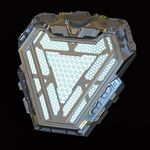Cosmic Vermillion Armor: Difference between revisions
| Line 33: | Line 33: | ||
[[File:HeavenlyVermillionArmorBox.jpeg|thumb|upright|left|150px|The armor in its box form]] | [[File:HeavenlyVermillionArmorBox.jpeg|thumb|upright|left|150px|The armor in its box form]] | ||
The armor uses the wearer's energy to activate its celestial mechanisms. When the wearer's energy connects with the armor, it forms a strong shield around them, protecting them with a glowing aura. While powerful, the armor can be destroyed, but only by the strength on par with the highest angel. | The armor uses the wearer's energy to activate its celestial mechanisms. When the wearer's energy connects with the armor, it forms a strong shield around them, protecting them with a glowing aura. While powerful, the armor can be destroyed, but only by the strength on par with the highest angel. During the [[World War 3]], the [[Devil]] was capable of damaging the armor, although not completely destroying it. | ||
The Heavenly Vermilion Armor can handle extremely hot and cold temperatures. It can endure freezing cold at -273.15 degrees Celsius (Absolute Zero) and 142 nonillion kelvins—the highest possible temperature. This ability lets the armor withstand powerful forces, even those comparable to a big bang, and allows for incredibly fast combat--even close to the speed of light. | The Heavenly Vermilion Armor can handle extremely hot and cold temperatures. It can endure freezing cold at -273.15 degrees Celsius (Absolute Zero) and 142 nonillion kelvins—the highest possible temperature. This ability lets the armor withstand powerful forces, even those comparable to a big bang, and allows for incredibly fast combat--even close to the speed of light. | ||
Revision as of 15:41, 6 August 2023
This article is incomplete because it is pending further input from participants, or it is a work-in-progress by one author. Please comment on this article's talk page to share your input, comments and questions. Note: To contribute to this article, you may need to seek help from the author(s) of this page. |
| Heavenly Vermillion Armor | |
|---|---|
 Heavenly Vermillion Armor in full body form | |
| Type | Combat Body Armor |
| Place of origin | New Eden (formerly) Orientia |
| Service history | |
| In service | Present |
| Used by | Mugen |
| Wars | World War 3 War of Dusk and Dawn |
| Production history | |
| Designer | Galadrim |
| Manufacturer | Hurite Divine Armoury |
| Produced | 900 AD (Earth time) 1887 ET (New Eden time) |
Heavenly Vermillion Armor (Hurite: Serayon Hashamayim Hasagoli; Japanese: 天空紅蓮の鎧) is a combat body armor owned by Mugen, and was used during the World War 3 and briefly in the War of Dusk and Dawn. It is of the highest class of many armors used by Hurite knights, comparable to that of the Angels' armors.
History
The armor itself has a rather vague history, but Hurite records have shown that the armor was made during the Age of Unification in New Eden, sometime around 1887 ET (or 900 AD in Earth time). It was known to be made from the most precious gold, believed to have descended from the heaven, by the legendary Hurite blacksmith, Galadrim.
Specification
The armor uses the wearer's energy to activate its celestial mechanisms. When the wearer's energy connects with the armor, it forms a strong shield around them, protecting them with a glowing aura. While powerful, the armor can be destroyed, but only by the strength on par with the highest angel. During the World War 3, the Devil was capable of damaging the armor, although not completely destroying it.
The Heavenly Vermilion Armor can handle extremely hot and cold temperatures. It can endure freezing cold at -273.15 degrees Celsius (Absolute Zero) and 142 nonillion kelvins—the highest possible temperature. This ability lets the armor withstand powerful forces, even those comparable to a big bang, and allows for incredibly fast combat--even close to the speed of light.
When not in use, the armor is kept in a medium-sized, box-shaped artifact. When activated, it transforms into the shape of a Vermilion Bird, a mythical creature that symbolizes immortality. If activated, each part of the armor attaches accordingly to the wearer's body.
See Also
References

